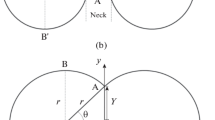Abstract
This paper aims to study the coalescence phenomenon of two different polymers PVDF and PMMA. The paper is divided in two parts: the first part is devoted to the experimental work, and the second one focuses on the modeling of the coalescence phenomenon. The first step was a physicochemical and rheological characterization. Then, the coalescence tests have been performed on droplets derived from PVDF and PMMA polymers using a polarized light optical microscope combined with a hot stage. The effect of several significant parameters like temperature and particle size was investigated. The second part of this study is focused on the modeling of the coalescence phenomenon based on the well-known Bellehumeur model. The latter has been commonly used to describe the coalescence phenomenon between identical grains. The novelty of the present work consists in the extension of the coalescence model to wider describe the coalescence phenomenon between grains of different polymers. In addition, probabilistic analysis was performed in order to investigate the effect of the parameters governing the coalescence model, namely the viscosity, the surface tension and the relaxation time. The results have shown a good compromise between the experimental results and the predictive generalized Bellehumeur model.












Similar content being viewed by others
References
Bellehumeur CT, Bisaria MK, Vlachopoulos J (1996) An experimental study and model assessment of polymer sintering. Polym Eng Sci 36:2198–2207. doi:10.1002/pen.10617
Bellehumeur CT, Kontopoulou M, Vlachopoulos J (1998) The role of viscoelasticity in polymer sintering. Rheol Acta 37:270–278. doi:10.1007/s003970050114
Bellehumeur CT (1997) Polymer sintering and its role in rotational molding. Thesis
Rosenzweig N, Narkis M (1981) Sintering rheology of amorphous polymers. Polym Eng Sci 21:1167–1170. doi:10.1002/pen.760211709
Kuczynski GC, Neuville B, Toner HP (1970) Study of sintering of poly(methyl methacrylate). J Appl Polym Sci 14:2069–2077. doi:10.1002/app.1970.070140815
Rosenzweig N, Narkis M (1981) Observation and analysis technique for studying sintering of polymeric particles. J Appl Polym Sci 26:2787–2789. doi:10.1002/app.1981.070260828
Hornsby PR, Maxwell AS (1992) Mechanism of sintering between polypropylene beads. J Mater Sci 27:2525–2533. doi:10.1007/BF01105065
Aid S, Eddhahak A, Ortega Z et al (2017) Experimental study of the miscibility of ABS/PC polymer blends and investigation of the processing effect. J Appl Polym Sci. doi:10.1002/app.44975
Frenkel J (1945) Viscous flow of crystalline bodies under the action of surface tension. J Phys 4:385–431
Rosenzweig N, Narkis M (1981) Dimensional variations of two spherical polymeric particles during sintering. Polym Eng Sci 21:582–585. doi:10.1002/pen.760211003
Pokluda O, Bellehumeur CT, Vlachopoulos J (1997) Modification of Frenkel’s model for sintering. AIChE J 43:3253–3256. doi:10.1002/aic.690431213
Ramos JI, Joseph DD (1991) Fluid dynamics of viscoelastic liquids. Appl Math Model 15:662–663
Asgarpour M, Bakir F, Khelladi S et al (2011) Characterization and modeling of sintering of polymer particles. J Appl Polym Sci 119:2784–2792. doi:10.1002/app.32924
Hamidi A, Farzaneh S, Nony F et al (2016) Modelling of sintering during rotational moulding of the thermoplastic polymers. Int J Mater Form 9:519–530. doi:10.1007/s12289-015-1239-6
Andreas JM, Hauser EA, Tucker WB (1937) Boundary tension by pendant drops 1. J Phys Chem 42:1001–1019. doi:10.1021/j100903a002
Jaynes ET (1957) Information theory and statistical mechanics. Phys Rev 106:620–630. doi:10.1103/PhysRev.106.620
Bellehumeur CT, Tiang JS (2002) Simulation of non-isothermal melt densification of polyethylene in rotational molding. Polym Eng Sci 42:215–229. doi:10.1002/pen.10942
Acknowledgement
The authors would like to acknowledge the financial support of the Chaire Mines Urbaines and Marianne Fleury from Ecosystèmes (France).
Author information
Authors and Affiliations
Corresponding author
Rights and permissions
About this article
Cite this article
Aid, S., Eddhahak, A., Ortega, Z. et al. Predictive coalescence modeling of particles from different polymers: application to PVDF and PMMA pair. J Mater Sci 52, 11725–11736 (2017). https://doi.org/10.1007/s10853-017-1302-4
Received:
Accepted:
Published:
Issue Date:
DOI: https://doi.org/10.1007/s10853-017-1302-4




